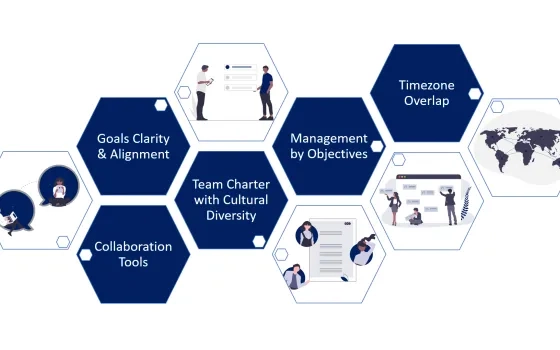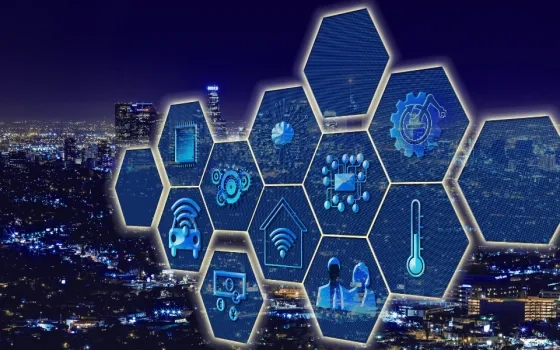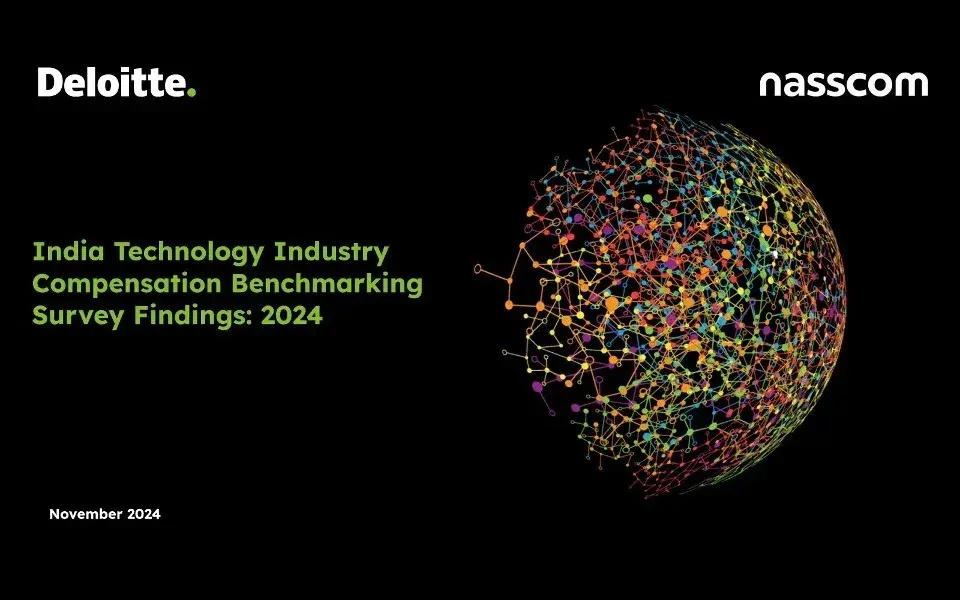A background to the DNA of great Virtual Teams
After Covid-19 started rampaging across the world, and businesses realized that open movement of its staff was going to be limited, Remote working suddenly boomed. We all know this.
Dr. Bill Dyment’s comments in this space, as quoted by Rob Asghar in his article “Now’s The Time To Build A Virtual Super-Team. Here’s How.”, were: In 2018, around 5 Million employees in the USA worked remotely – around 3.6% of the workforce. But these numbers have swelled significantly. Dr. Dyment has further stated that more than half of all U.S. workers could work from home, and a good many would continue to do so.
The situation in the rest of the world is no different.
As Kunal Kaul says in his article “Digital Disruption & Remote Working in the Post Covid World”, a “New Normal” is certain – where in-person and face-to-face interaction will be minimized, and transacting digitally and conducting business through virtual platforms is going to become increasingly prevalent and eventually a de facto standard.
As Slack has proposed as part of its “Report: Remote work in the age of Covid-19”,
- The Remote work wave has strengthened;
- Experience matters, for remote work;
- The transition can strain professional connections; and
- Collaboration tools can help.
So what does this mean for all of us?
From Remote work to Virtual teams
Moving from individual staff performing Remote work to Virtual teams is but a single step. As the staff in an organization all move to Work-from-Home, the need for Virtual teams is very clear.
The important question, though, is: How do we make Virtual teams successful?
An equally important corollary is: What are the factors that deter the success of Virtual teams?
Keith Ferrazzi, in his HBR article “Getting Virtual Teams Right”, has identified the key Must-haves for a successful Virtual team:
- The Right team: People with the right attitude, Emotional Intelligence, & independence; Optimal team size; Clarity of roles & responsibilities.
- The Right leadership: Prior experience of leading virtual teams; Fostering trust; Encouraging dialogue; Clarifying goals and guidelines.
- The Right touchpoints: Kickoff meeting; Effective Onboarding; Setting Milestones.
- The Right technology: Varieties of communication channels to support collaboration & engagement.
The above enablers definitely forms the backbone of a long-term strategy for effective Virtual teams.
The downside is: It can only be achieved in the long-term. Hiring is always a long-term exercise: Publish jobs, short-list candidates, conduct Technical & HR interviews, Issue Offers, wait for the candidates’ Notice period to get over, and then onboard the new joinees. There is no way that we can cut corners & save time if we are to hire the right candidates.
At this time, companies do not have the flexibility of a long-term runway to transform to effective Virtual teams. Simply put, we have already run out of time, and we need to implement Virtual teams now.
Therefore: we also need short-term, tactical approaches that we can adapt and adopt right now.
This is the driver that is pushing the need to develop and implement a clone-able DNA for effective Virtual teams: A set of approaches & steps that are focused on the now & here, instead of 6-to-18 months down the line.
The DNA of effective Virtual Teams
A DNA, or Deoxyribonucleic acid, is a molecule that contains the biological instructions that make each species unique, and is made of chemical building blocks called nucleotides.
I believe that the DNA of an effective Virtual Team is similarly built using key enablers, and the key enablers for effective Virtual teams are:
- Clarity of Goals & Objectives
- Team Charter
- Management by Objectives or MBO
- Strong Collaboration mechanisms, and
- Minimization of Timezone differences.
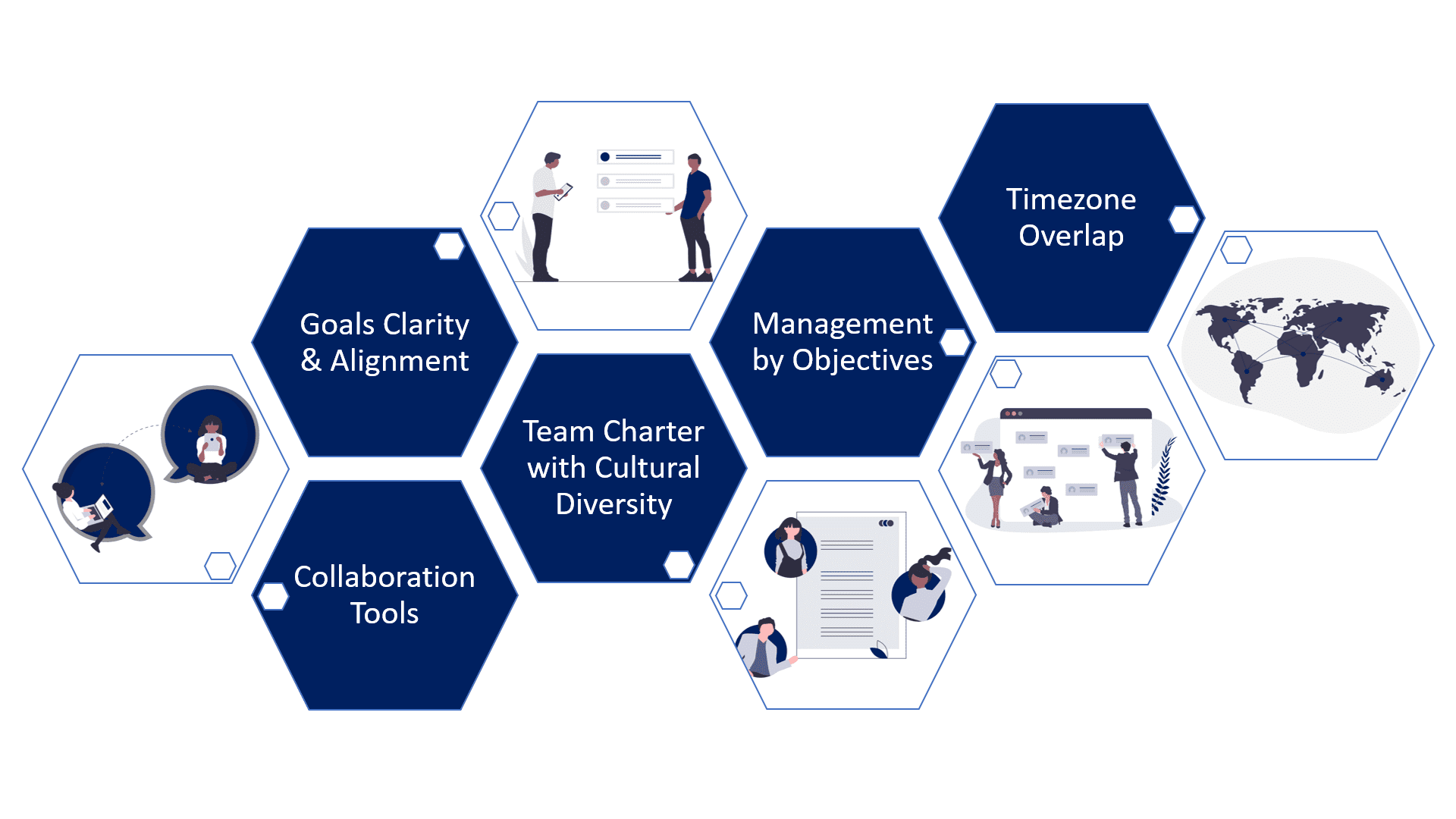
Now, lets dig deeper into each of these Key enablers in more detail.
Clarity of Goals & Objectives
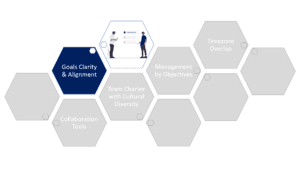
Any organization will be successful only if its employees are fully aligned with the organization’s vision, mission, values, and strategy.
I am not going into more detail about the importance of Company Vision, Mission, and Values. Instead, here’s an article that describes it in good detail.
The key takeaways from Torben Rick on this topic, are:
- The most critical element in any strategy is its translation into reality. The only true measure of success is in its execution.
- One of the key determinants of successful strategy implementation is organizational alignment.
- Without alignment, the best strategic plan will never be fully achieved, because organizational alignment is the glue that makes strategy execution excellence happen.
- An aligned organization gets things done faster, with less effort, and with better results, and is more agile and responsive to changing business conditions.
So how is this relevant in the context of Virtual teams?
If the entire team is cognizant of the objectives & constraints of their work, and are able to relate to each other’s tasks and dependencies, then the likelihood of project success is dramatically increased as the team starts pulling together.
Think about a championship soccer team. Each player has his/her position: Goalie, Full back, Mid-fielder, Forward, etc. Even if all of the players are highly skilled, the team will not be successful unless each player plays well to his/her position. The high-level common objective of the entire team is to score goals against the opposing team, while preventing the opposing team in scoring goals in their own goalpost. The high-level objective can only be achieved by leveraging the individual strategies & tactics of each position and player, in a manner that is supporting one another. The same individual strategies & tactics may in fact fail, if they are not well aligned to and supporting one another. This is why “Team playing” has such high significance in most sports.
Team Charter
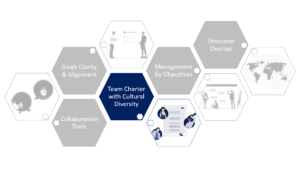
Moving beyond Goals clarity: In a normal office, where most of the staff are co-located, and line-of-sight management is exercised, Organizational alignment is easier to implement.
- The day-to-day behaviour of the leaders & other staff normally reflect the values of the company.
- The dressing, behaviour, and attitude of staff also reflect and are reinforced in a physical office environment.
- Aspects such as the working style: Focus on your work (computer/ phone/ other mechanism); Taking breaks; Start & End time; etc are naturally enforced in a physical office environment, both by the setting of expectations at the time of hiring, as well as via the behaviour of colleagues in the workplace.
- The values & behavioural norms are both reflected and reinforced even to the level of furnishing of offices, driving values such as openness, transparency, etc. (Eg, an Open-door policy).
But in a Virtual team environment, specially in WFH (Work from Home) situations like we have now, there are other natural interruptions to the working cycles & working styles. Not every employee can afford a dedicated office, so interruptions from family members are highly likely to occur.
The impact of such interruptions on the work day of the employee will need to be contained by the employees themselves – But self-discipline may not be adequate.
In a global company, employees may be from different geographical locations; from different societal strata; from vastly different cultures; etc. What this implies is that each individual’s natural responses to the same stimuli could be very different. This is called Cultural diversity.
Within the physical context of an office, these natural responses would be toned down. But in the WFH environment, the impact of these can be far stronger.
Hence we need to lay down clear and formal guidelines around how the team can work, interact with one another, etc.
A Team Charter, specially designed for the team’s context of cultural diversity, would go a long way in clarifying to the team about the right ways to operate while working remotely.
It is to be noted that the Team Charter developed shall incorporate the Cultural diversity of the Company and its ecosystem (Customers, Partners, Vendors, Affiliates, etc), in order to be most effective.
Management by Objectives
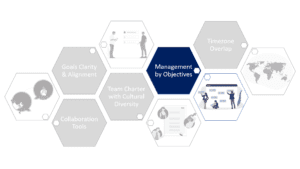
In the traditional office environment, management oversight is frequently achieved by line-of-sight management, or Management by Walking Around (MBWA).
Naturally, this is not possible in a Virtual team implementation. So what would be an effective alternative for MBWA in the Virtual team scenario?
Management by objectives (MBO) is a strategic management model that aims to improve the performance of an organization by clearly defining objectives that are agreed to by both management and employees. According to the theory, having a say in goal setting and action plans encourages participation and commitment among employees, as well as aligning objectives across the organization.
However, care has to be taken that implementation of MBO does not generate distrust and hostility, due to the increased dependence on performance measurement systems. Read more about this implication here.
Hence it is important that MBO adoption is fine-tuned using an active engagement model such as Daily Standup meetings.
Collaboration Tools

Deep collaboration has to be a strong underpinning of any Virtual team, in order for it to be effective.
In a Traditional office, employees could simply walk over to a colleague and chat, and close an action. If there was a need to meet as a team, they could walk into a Conference room, brainstorm, and finalize the ways forward. They had a Whiteboard in the Conference room that could be used to jot down key points or draw flows, etc.
In a Virtual team scenario, this is not possible in the normal course.
Hence, a tool is critical to the operation of an effective Virtual team – One that can support functionalities such as: Messenger, Group chat, Whiteboard, Screen sharing, File sharing, etc.
Timezone Overlap
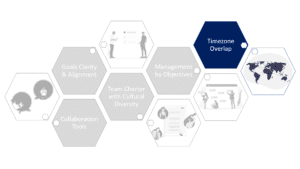
In a global company scenario, Virtual team members could be located in different parts of the world. This adds to the pain of a Virtual team, as some of the team members will be pushed to work outside their regular work days, sometimes by 12 hours or even more.
This adds to operating friction, and will start impacting other operating aspects as well.
Can we completely avoid this? Probably not.
But we can minimize the impacts by:
- Adjusting the work timings to minimize the pain for the maximum number of team members.
- Implementing a rotational system for setting the “Base Operating Timezone”, possibly rotating the base Timezone every 2 weeks/ 1 month, etc.
A step back – and a look forward
Back in 2013, when Marissa Mayer banned working from home for Yahoo!, everyone thought that Remote work was dead. However, Telecommuting & Remote work continued to endure and grow. And with Covid, Remote work has exploded, and is clearly here to stay.
The mindset of a lot of people has now changed to a more risk-averse stance vis-à-vis contacts & engagement in the workplace, and it is likely that even after Covid and Social distancing norms are behind us, people would still prefer to continue with Remote work. And with this will come the continuing need for effective Virtual teams.
So the bottomline is: Companies and individuals have to define and execute customized action plans to implement and fine-tune their Virtual teams.
Large enterprises like TCS have taken the decision that 75% of its workforce, which is approximately 4,48,000 global employees, will permanently to a Work-from-Home model by 2025. To enable this, TCS is deploying its operating model called Secure Borderless Work Spaces or SBWS.
Conclusion
Other large Enterprises can also build their own versions of SBWS, and would have the necessary Cashflows & financial muscle power to withstand a transformation to a Virtual operating model.
Relatively small- to medium-sized firms would not, however, be able to afford the development & deployment of their own SBWS equivalents.
So what can small- to medium-sized firms do in this context?
They can clone the Virtual Team strategy as described above, and drive up effectiveness.
For this, the critical elements would necessarily include:
- Company leadership that considers its geographical spread, team composition, existing operational processes, etc, and designs & implements a Company culture that takes into consideration aspects such as Cultural diversity, Timezone differences, etc, and further, develops & implements an operating Team Charter that envisions the future of work for the Company;
- Company-wide adoption of Service Delivery methodology and Management System, that enables the effective adoption of the above operating Team Charter; AND
- A Platform that:
- Provides the ability to decompose and qualify Business needs in a componentized and trackable manner;
- Provides the ability to deliver and manage the Work outcomes in an incremental manner;
- Enables collaborative team-working and forces Team engagement; AND
- Facilitates the adoption of the Company culture & Company Management System, as described above.
The above elements must necessarily force together the capabilities of Business Expectations management, Company Goals clarity, Management by Objectives, and Team Engagement, and will jointly be critical for its transformation into an effective Delivery Organization that works equally well in both remote or proximate engagement models.
Note:
This Blog post was first published on the gigsboard.com Blog on 27-Jul-2020.



